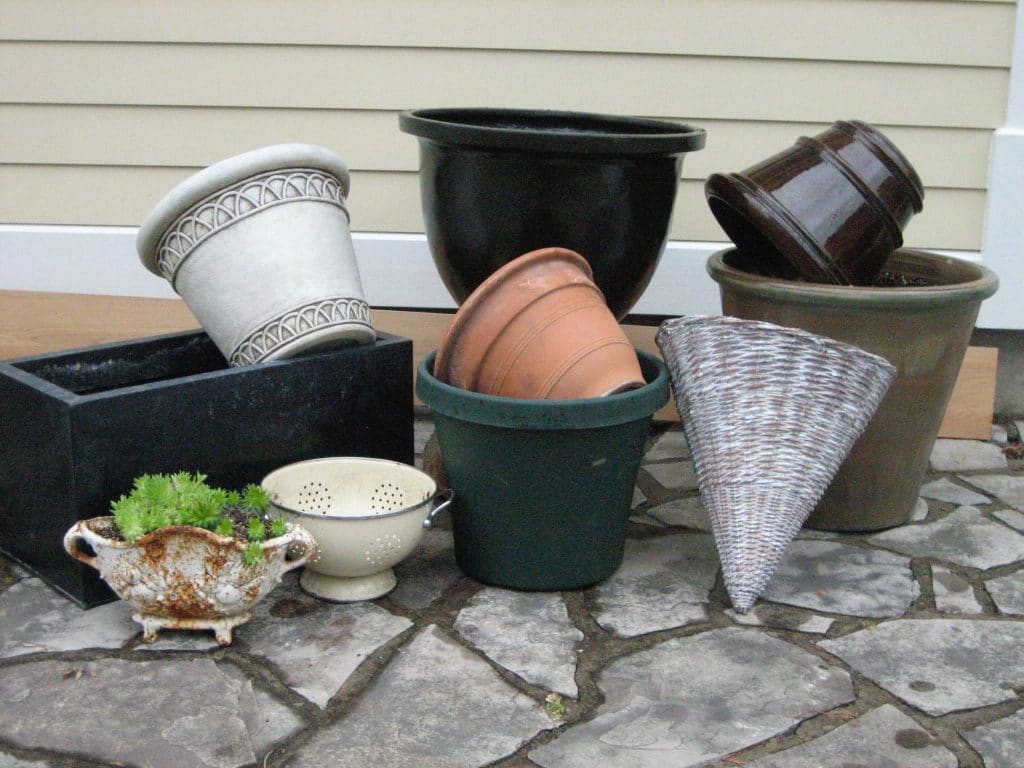
Even before you think about what plants you’ll grow in your container garden, consider what garden pots you have on hand, what needs replacing and what you need to acquire.
Almost anything that holds soil and water will work as a container for plants, but consider practicalities and aesthetics, too. The larger the container, the more room there is for a beautiful display of plants, a well as the soil and water needed to keep them thriving. When in doubt, go big. Large containers have more visual impact in the landscape.
When considering materials, keep in mind the weight of a container once it’s filled — moist potting soil is heavy. If you’re creating a potscape above ground level, make sure your balcony can tolerate the weight load. Plastic and fiberglass are lighter than wood and concrete, but dark-coloured plastic heats up in the sun. Some plants don’t like to have their roots cooked. Terra-cotta pots are classic beauties and allow a healthy exchange of oxygen around roots, but they do dry out more quickly than containers made of more solid materials. Concrete is practical and frost-resistant, but heavy. They’re perfect for large containers that will stay in place year-round.

Whatever you choose, make sure there is a drainage hole at the bottom. When watering a container, it’s important to make sure water reaches the very bottom, otherwise roots will grow in just the top few inches. However, any excess water needs to have a way to drain away to ensure plant roots don’t rot. Covering the holes with potshards or gravel is a bad idea — it impedes drainage, rather than improving it. Potshards and gravel also take up valuable space needed for soil and root growth — both of which help plants reach their full potential. Place a square of window screening or a coffee filter over the hole before filling with potting soil to keep the soil in and allow excess water to escape.
Then there are the myriad household items that can be repurposed for container gardens — colanders, baskets, old boots, whatever. Some may need a clear plastic lining to be practical. Be sure to puncture a few holes in the bottom for that all-important drainage and trim off the top edge to just below the top of your container.
As far as aesthetics go, it’s your garden, so choose what makes you and your plants happy. However, by limiting the different kinds of container materials and design styles, you’ll create a more unified, cohesive look.


I like to try an Grow Dahlias in containers How do I go about it ? Thx You
Hi Bill,
Here’s how I grow a dahlia tuber in a container. Choose a large container (at least 12 inches deep and wide) and fresh potting soil. (Not soil from your garden; it’s too heavy and doesn’t drain well.) Dahlias need full sun, so locate the container in a sunny spot. Make sure the drainage hole in the bottom of the pot isn’t covered with pot shards or gravel. Shorter dahlias are easier to grow in containers than taller varieties. Tall varieties need staking and wind may blow the container over. Hollow out a four-inch depression in the soil and place the tuber (or cluster of tubers) on its side. Most tubers you purchase will have a little shoot or growth tip beginning to emerge–make sure this is pointing up. Then, cover the tuber with moist potting soil and let the tip of the shoot just barely peek above the top of the soil. As the shoots grow, gradually fill in the depression with soil.
Start with well-moistened potting soil and avoid overwatering, especially when the tuber is just beginning to put out new growth. Once the shoots are emerging and lengthening, keep the soil evenly moist.
Hi I am a new gardener & would love to get more information via e-mail
Hi Lisa, Welcome! Although, please be warned that gardening can be a little addictive! You can sign up for our e-newsletters here: https://gardenmaking.com/email-newsletter-signup/